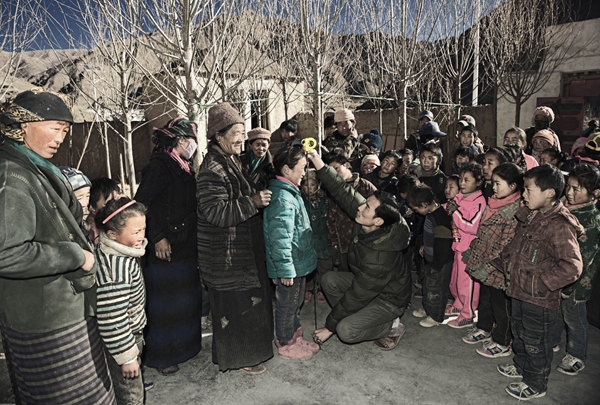Hello to the New Good Life
China Today by Zhang Xiao, November 3, 2016 Adjust font size:
Just five years ago, residents of Bading Village, Chagjug Town, Sagya County, Xigaze City in Tibet Autonomous Region (TAR) had neither running water nor electricity. Owing to poor transport and telecommunications they lived in almost total social isolation. However, great changes have occurred in that short space of time. Solar street lighting, a local area network (LAN), and the construction of a cement road have given the village a brand new look. All these changes are thanks to the efforts of a work team sent by the TAR Department of Science and Technology.
Tailor-made Plans to Benefit Local Residents
Bading Village is one of three sites in Chagjug Town to which the TAR Science and Technology Department sent a team to help the local poverty alleviation effort. Compared with the two other villages, Bading is more remote and, with no electricity, conditions there were even worse.

Losang, a stationed cadre, measures the children so he can help buy them new winter clothes.
Extremely ragged infrastructure was the biggest challenge facing the team of cadres stationed in the village. Locals eked out a living through farming and herding, and with no running water, electricity, roads or telecommunications, life was primitive. Upon arrival in Bading, the team immediately set about visiting local households to determine their needs. They could then make targeted plans to maintain local stability, promote economic development, and solve various problems. They decided to focus their efforts on improving local infrastructure, helping locals increase their incomes, and transforming the economic development mode. The team accordingly sketched out a three-year and five-year plan for the village.
With the support of local government at both county and township levels, the work team stationed in Bading used all available channels to supply the village with electricity and enable locals to communicate with each other and the outside world. They built a road, an irrigation reservoir, and a potable water supply system. They also launched training schemes for local government officers to enable them to better serve local people, and helped to establish rural cooperatives.
The Tibet Department of Science and Technology endorsed the establishment of four vegetable greenhouses and a 3.3-plus hectare planting area for alfalfa. It also set up an agricultural processing plant, a chicken farm with egg incubators, a potable water supply, a well, and a village clinic, according to Chimed Tsering, leader of the village-stationed cadre team and secretary of the Bading Village Committee of the Communist Party of China (CPC). All the newly established facilities have met the basic needs of local people and substantially improved their environment and living conditions.
“In the past, local people ate few vegetables other than potatoes and radishes. Since the construction of greenhouses, they have a choice of various leafy green vegetables. The agricultural processing factory produces flour, oil, and Tsampa, the Tibetan staple food, so villagers don’t need to go elsewhere to buy these foodstuffs at high prices,” Chimed Tsering said.